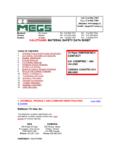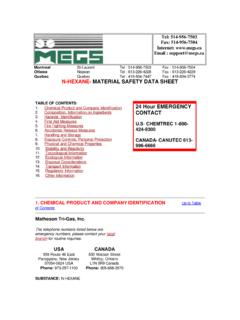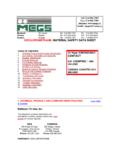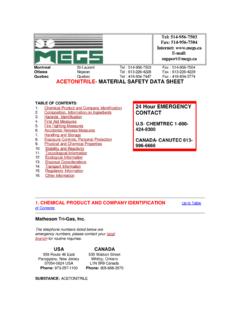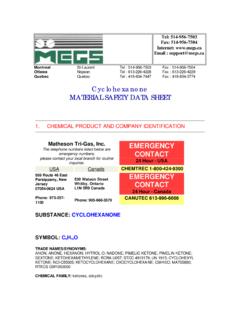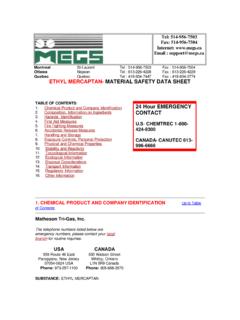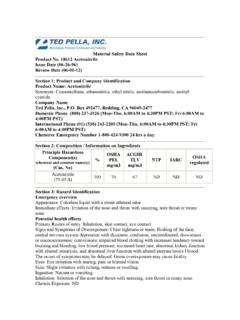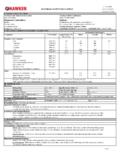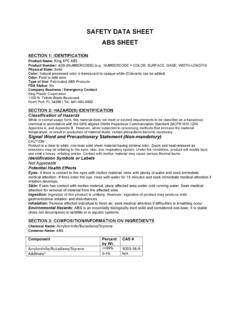Transcription of ACRYLONITRILE- MATERIAL SAFETY DATA SHEET …
1 Tel: 514-956-7503 Fax: 514-956-7504 Internet: E-mail: Montreal St-Laurent Tel : 514-956-7503 Fax : 514-956-7504 Ottawa Nepean Tel : 613-226-4228 Fax : 613-226-4229 Quebec Quebec Tel : 418-834-7447 Fax : 418-834-3774 acrylonitrile - MATERIAL SAFETY data SHEET TABLE OF CONTENTS: 1. Chemical Product and Company Identification 2. Composition, Information on Ingredients 3. Hazards Identification 4. First Aid Measures 5. Fire Fighting Measures 6. Accidental Release Measures 7. Handling and Storage 8. Exposure Controls, Personal Protection 9. Physical and Chemical Properties 10. Stability and Reactivity 11. Toxicological Information 12. Ecological Information 13. Disposal Considerations 14.
2 Transport Information 15. Regulatory Information 16. Other Information 24 Hour EMERGENCY CONTACT CHEMTREC 1-800-424-9300 CANADA- CANUTEC 613-996-6666 1. CHEMICAL PRODUCT AND COMPANY IDENTIFICATION-----------Up to Table of Contents Matheson Tri-Gas, Inc. The telephone numbers listed below are emergency numbers, please contact your local branch for routine inquiries. USA 959 Route 46 East Parsippany, New Jersey 07054-0624 USA Phone: 973-257-1100 CANADA 530 Watson Street Whitby, Ontario L1N 5R9 Canada Phone: 905-668-3570 SUBSTANCE: acrylonitrile SYMBOL: C3H3NO TRADE NAMES/SYNONYMS: 2-PROPENENITRILE; PROPENENITRILE; VINYL CYANIDE; CYANOETHYLENE; acrylonitrile ; AN; VCN; ACRYLON; CARBACRYL; VENTOX; FUMIGRAIN; STCC 4906420; RCRA U009; ENT 54; UN 1093; MAT00370; RTECS AT5250000 CHEMICAL FAMILY: nitriles, aliphatic CREATION DATE: Jan 24 1989 REVISION DATE: Mar 16 1999 2.
3 COMPOSITION, INFORMATION ON INGREDIENTS-----------Up to Table of Contents COMPONENT: acrylonitrile , INHIBITED CAS NUMBER: 107-13-1 EC NUMBER (EINECS): 203-466-5 PERCENTAGE: >99 COMPONENT: METHYLHYDROQUINONE CAS NUMBER: 95-71-6 EC NUMBER: 202-443-7 PERCENTAGE: < 3. HAZARDS IDENTIFICATION-----------Up to Table of Contents NFPA RATINGS (SCALE 0-4): HEALTH=4 FIRE=3 REACTIVITY=2 WHMIS CLASSIFICATION: BD1 EC CLASSIFICATION (ASSIGNED): F Highly Flammable T Toxic Xi Irritant Carcinogen Category 2 R 11-23/24/25-38-45 EC Classification may be inconsistent with independently-researched data . EMERGENCY OVERVIEW: Color: colorless Physical Form: liquid Odor: pungent odor Major Health Hazards: harmful (if inhaled, on contact with the skin, or swallowed), eye burns, respiratory tract irritation, skin irritation, allergic reactions, cancer hazard (in humans) Physical Hazards: Flammable liquid and vapor.
4 Vapor may cause flash fire. May polymerize. Containers may rupture or explode. POTENTIAL HEALTH EFFECTS: INHALATION: Short Term Exposure: irritation, itching, nausea, vomiting, diarrhea, stomach pain, irregular heartbeat, headache, drowsiness, dizziness, bluish skin color, suffocation, convulsions, coma Long Term Exposure: digestive disorders, reproductive effects, cancer SKIN CONTACT: Short Term Exposure: irritation (possibly severe), allergic reactions, blisters, suffocation Long Term Exposure: same as effects reported in short term exposure EYE CONTACT: Short Term Exposure: burns, tearing, eye damage Long Term Exposure: same as effects reported in short term exposure INGESTION: Short Term Exposure: suffocation Long Term Exposure.
5 Reproductive effects, cancer CARCINOGEN STATUS: OSHA: Y NTP: Y IARC: Y 4. FIRST AID MEASURES-----------Up to Table of Contents INHALATION: When safe to enter area, remove from exposure. Use a bag valve mask or similar device to perform artificial respiration (rescue breathing) if needed. Get medical attention immediately. SKIN CONTACT: Remove contaminated clothing, jewelry, and shoes immediately. Wash with soap or mild detergent and large amounts of water until no evidence of chemical remains (at least 15-20 minutes). Get medical attention, if needed. EYE CONTACT: Wash eyes immediately with large amounts of water, occasionally lifting upper and lower lids, until no evidence of chemical remains. Continue irrigating with normal saline until ready to transport to hospital.
6 Cover with sterile bandages. Get medical attention immediately. INGESTION: Contact local poison control center or physician immediately. Never make an unconscious person vomit or drink fluids. When vomiting occurs, keep head lower than hips to help prevent aspiration. If person is unconscious, turn head to side. Get medical attention immediately. ANTIDOTE: amyl nitrite, inhalation; sodium nitrite, intravenous; sodium thiosulfate, infusion; oxygen. NOTE TO PHYSICIAN: Consider amyl nitrite inhalation, 1 ampoule ( mL) every 5 minutes, and oxygen. For ingestion, consider gastric lavage. Consider oxygen. 5. FIRE FIGHTING MEASURES-----------Up to Table of Contents FIRE AND EXPLOSION HAZARDS: Severe fire hazard. Moderate explosion hazard.
7 Vapor/air mixtures are explosive. May explode when heated. The vapor is heavier than air. Vapors or gases may ignite at distant ignition sources and flash back. EXTINGUISHING MEDIA: regular dry chemical, carbon dioxide, water, regular foam, alcohol resistant foam Large fires: Use regular foam or flood with fine water spray. FIRE FIGHTING: Do not get water inside container. Cool containers with water spray until well after the fire is out. Stay away from the ends of tanks. For fires in cargo or storage area: Cool containers with water from unmanned hose holder or monitor nozzles until well after fire is out. If this is impossible then take the following precautions: Keep unnecessary people away, isolate hazard area and deny entry.
8 Let the fire burn. Withdraw immediately in case of rising sound from venting SAFETY device or any discoloration of tanks due to fire. For tank, rail car or tank truck, evacuation radius: 800 meters (1/2 mile). Water may be ineffective. FLASH POINT: F ( C) (CC) LOWER FLAMMABLE LIMIT: 3% UPPER FLAMMABLE LIMIT: 17% AUTOIGNITION: 898 F (481 C) FLAMMABILITY CLASS (OSHA): IA 6. ACCIDENTAL RELEASE MEASURES-----------Up to Table of Contents WATER RELEASE: Subject to California Safe Drinking Water and Toxic Enforcement Act of 1986 (Proposition 65). Keep out of water supplies and sewers. OCCUPATIONAL RELEASE: Avoid heat, flames, sparks and other sources of ignition. Do not touch spilled MATERIAL . Stop leak if possible without personal risk.
9 Reduce vapors with water spray. Small spills: Flood with water. Large spills: Dike for later disposal. Remove sources of ignition. Keep unnecessary people away, isolate hazard area and deny entry. Reportable Quantity (RQ): Notify Local Emergency Planning Committee and State Emergency Response Commission for release greater than or equal to RQ ( SARA Section 304). If release occurs in the and is reportable under CERCLA Section 103, notify the National Response Center at (800)424-8802 (USA) or (202)426-2675 (USA). 7. HANDLING AND STORAGE-----------Up to Table of Contents Store and handle in accordance with all current regulations and standards. Notify State Emergency Response Commission for storage or use at amounts greater than or equal to the TPQ ( EPA SARA Section 302).
10 SARA Section 303 requires facilities storing a MATERIAL with a TPQ to participate in local emergency response planning ( EPA 40 CFR ). Protect from physical damage. Store outside or in a detached building. Store with flammable liquids. Keep separated from incompatible substances. Monitor inhibitor content. Secure to prevent tipping. Use diking sufficient to contain total contents plus 10%. Keep separated from incompatible substances. 8. EXPOSURE CONTROLS, PERSONAL PROTECTION-----------Up to Table of Contents EXPOSURE LIMITS: acrylonitrile , INHIBITED: acrylonitrile : 2 ppm OSHA TWA 10 ppm OSHA ceiling 15 minute(s) 2 ppm ( mg/m3) ACGIH TWA (skin) 1 ppm NIOSH recommended TWA 8 hour(s) 10 ppm NIOSH recommended ceiling 15 minute(s) (skin) VENTILATION: Provide local exhaust or process enclosure ventilation system.
